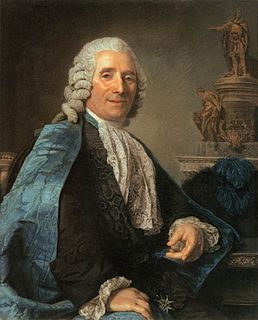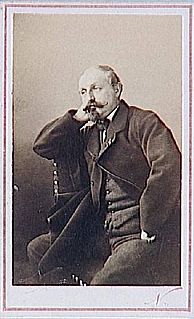
Jean-Baptiste Delestre was a French artist and writer upon art. His painting "Scene during the eruption of Vesuvius" is displayed in the Museum of Nantes.

Jean-Baptiste Delestre was a French artist and writer upon art. His painting "Scene during the eruption of Vesuvius" is displayed in the Museum of Nantes.
Delestre was born at Lyons in 1800. He was a pupil of Gros, and he also studied water-colour painting and sculpture; after a time, he abandoned the practice of art, and devoted himself to history and criticism.
Paul-Èdouard Delabrièrre studied painting under Delestre before eventually turning to sculpture. [1]
He was a radical in politics, and took an active part in the French Revolution of 1848. His painting "Scene during the eruption of Vesuvius" is displayed in the Museum of Nantes. His principal writings were "Études progressives des têtes du Cénacle peint a Milan par Leonard de Vinci" (1827) and "Gros et ses ouvrages" (1867).
He died in Paris in 1871.

Jean-Baptiste-Siméon Chardin was an 18th-century French painter. He is considered a master of still life, and is also noted for his genre paintings which depict kitchen maids, children, and domestic activities. Carefully balanced composition, soft diffusion of light, and granular impasto characterize his work.

The Barbizon school of painters were part of an art movement towards Realism in art, which arose in the context of the dominant Romantic Movement of the time. The Barbizon school was active roughly from 1830 through 1870. It takes its name from the village of Barbizon, France, on the edge of the Forest of Fontainebleau, where many of the artists gathered. Most of their works were landscape painting, but several of them also painted landscapes with farmworkers, and genre scenes of village life. Some of the most prominent features of this school are its tonal qualities, color, loose brushwork, and softness of form.

Jean-Baptiste Pigalle was a French sculptor.

JeanFouquet (ca.1420–1481) was a French painter and miniaturist. A master of panel painting and manuscript illumination, and the apparent inventor of the portrait miniature, he is considered one of the most important painters from the period between the late Gothic and early Renaissance. He was the first French artist to travel to Italy and experience first-hand the early Italian Renaissance.

Antoine-Jean Gros was a French painter of historical subjects. He was given title of Baron Gros in 1824.

Carle or Charles-André van Loo was a French painter, son of the painter Louis-Abraham van Loo, a younger brother of Jean-Baptiste van Loo and grandson of Jacob van Loo. He was the most famous member of a successful dynasty of painters of Dutch origin. His oeuvre includes every category: religion, history painting, mythology, portraiture, allegory, and genre scenes.

Jean-Baptiste van Loo was a French subject and portrait painter.

Jean-Baptiste Santerre was a French painter and draughtsman of the Style Louis XIV, known for his history paintings, portraits, and portrait-like genre subjects. Considerably influenced by Italian masters of the Bolognese school as well as his French contemporaries, Santerre nonetheless made an original contribution in his art, being among the first French painters to bring Netherlandish influences.

Eugène Louis Lami was a French painter, watercolorist, lithographer, illustrator and designer. He was a painter of fashionable Paris during the period of the July Monarchy and the Second French Empire and also made history paintings and illustrations for books such as Gil Blas and Manon Lescaut.

Pierre Le Gros was a French sculptor, active almost exclusively in Baroque Rome where he was the pre-eminent sculptor for nearly two decades.

Nicolas Bernard Lépicié was an 18th-century French painter, the son of two well-known engravers at the time, François-Bernard Lépicié and Renée-Élisabeth Marlié, was introduced to the artistic and cultural environment by his parents.
Jan Karel Donatus van Beecq was a Dutch marine painter, active in England and later in France, where he became a member of the Academy in 1681.

Jacques-Henri Sablet (1749–1803) was a French painter, part of a family of artists of Swiss origin.

Joseph Louis Hippolyte Bellangé was a French battle painter and printmaker. His art was influenced by the wars of the first Napoleon, and while a youth, he produced several military drawings in lithography. He afterwards pursued his systematic studies under Gros, and with the exception of some portraits, devoted himself exclusively to battle-pieces. In 1824, he received a second class medal for a historical picture, and in 1834 the decoration of the Legion of Honour, of which Order he was made an officer in 1861. He also gained a prize at the Paris Universal Exhibition of 1855.

Bonaparte at the Pont d’Arcole is a 1796 painting by Antoine-Jean Gros, showing an episode during the Battle of Arcole in November 1796, with General Napoleon Bonaparte leading his troops to storm the bridge.

Claude François Théodore Caruelle d'Aligny (1798–1871) was a French landscape painter.
Joseph-Désiré Court was a French painter of historical subjects and portraits.

Auguste-Hyacinthe Debay was a French painter and sculptor.

Vesuvius in Eruption is the subject of a series of thirty paintings and at least one preliminary sketch by Joseph Wright of Derby, who travelled in Italy in the years 1773-1775. It appears that whilst Wright was in Italy Vesuvius was not erupting.

Jean-Baptiste Henri Durand-Brager (1814–1879) was a French painter, noted for his marine scenes and Orientalist works.